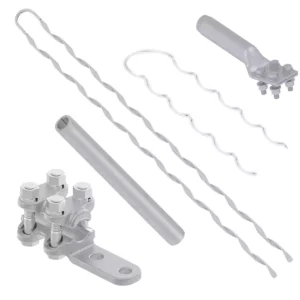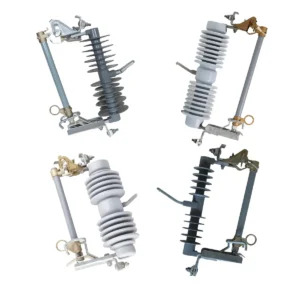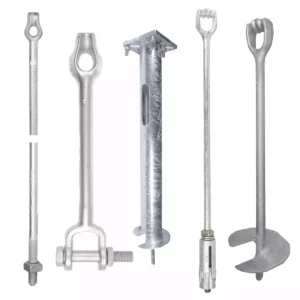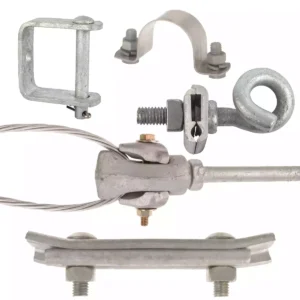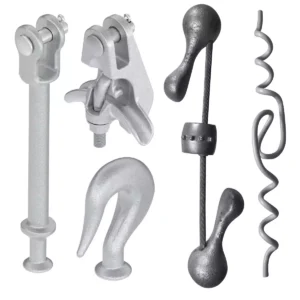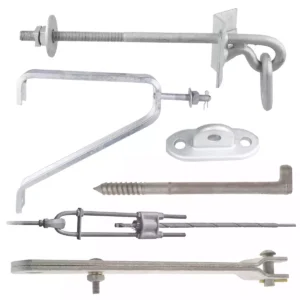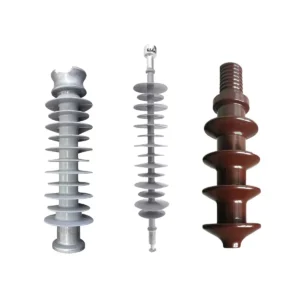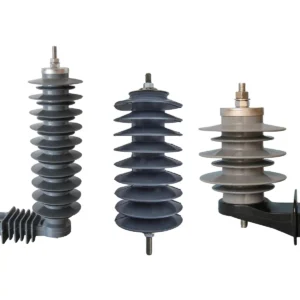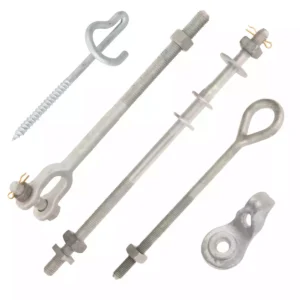Power Line Hardware
Power line hardware is the building blocks for any power and communication project, including surge arresters, overhead line connectors, power line insulators, utility fasteners, and more. These components assure the free passage of electricity and signal while protecting people and animals passing by. They also facilitate maintenance activities in harsh environment, improving efficiency and safety. Hardware components manufactured in accordance with international standards ensures quality and usability in various regions.
-

Conductor Hardware (72)
-

Cutout Fuse (23)
-

Grounding Anchor (101)
-

Line Construction Hardware (126)
-

Overhead Line Connector (142)
-

Pole Line Hardware (301)
-

Power Line Insulator (74)
-

Power Surge Arrester (21)
-

Utility Fastener (69)
Read More
Table of Contents
- Types of Power Line Hardware
- Properties of Utility Pole Fittings
- Application of Overhead Line Accessories
- Frequently Asked Questions
Power line hardware, or power line fittings, are all the additions used to connect and support the electric devices to repose the power supply on the power lines. They have some specific features which help is smooth flow of electricity such as:
- Have a smooth surface
- Should be hot dip galvanized
- They should be of accurate shapes and sizes
- Should have high breaking load capacity
- Should be of good quality
Types of Power Line Hardware
Steel cross arm
Steel cross arm, or steel crossarm, is a metallic component that provides support to distribution transformers, isolating links and fuses. They are used on overhead lines, distribution lines, transmission towers, transmission lines, utility poles and light poles. They are made from steel and provide support for minor devices on the utility poles.
Guy thimble
The guy thimble is mostly used on electric power lines to help connect the guy wire.
Pole band
Pole band is an accessory that is used to attach secondary racks to the pole which are then used to support other pole fitting and cables.
Anchor rods
Anchor rods are used in solid foundations to uphold steel columns, traffic signs and light poles. They are also called anchor bolts.
Guy clamps
These are used in pole lines to secure the stranded ends of a guy wire.
Secondary rack
Secondary rack is an insulator cable support used on the side or the inside of a pole. It’s designed in a way that it can support more than two conductors.
Secondary clevis
Secondary clevis is an insulator cable that is bashed from flat steel with a clevis pin that strings the spool insulator.
Stay rods
These galvanized steel rods that are used to connect the stay wire to the ground anchor.
Yoke plate
The yoke plate is used to connect the clevis, socket tongue, or insulators. It connect the insulators to the cross arm and to the conductor termination.
Ball clevis
The ball clevis is used to connect the socket insulator by the ball head.
Pole top pins
The pole top pins are made from steel and are used to connect insulator pins. They are also used for all the pole line and overhead line needs.
Pole top bracket
Pole top brackets are used to uphold post insulators on the top of the utility poles.
Properties of Utility Pole Fittings
Mechanical properties
These help to determine the working mechanisms of electrical power fittings. They also define the relation between a fitting and a conductor.
Material properties
The material a fitting is made out of should have high resistance to corrosion and abrasive forces. They therefore should be made by hard material, be galvanized or have stainless steel.
Design properties
The shape and structure of a fitting should be considered when selecting a fitting. The design determines the relationship between itself and a conductor or insulator. The factors should include diameter and dimensions, weight and angle, accurate and precise dimension.
Electrical properties
The power fittings should possess good electrical capabilities. Such include the ability to overcome a fault current and should prevent the loss of electric current brought about by relations between an electric and magnetic field.
Application of Overhead Line Accessories
Power fittings can be used for various purposes depending on the need for them. They can be used in telecommunication, aerospace, fabrication, mining and even medical to help in transmitting power in each department. They can be made from materials such as aluminum, platinum, steel, titanium and copper depending on where they are going to be used.
Some tests are conducted to ensure their strength and mitigate any weaknesses as they distribute and uphold utility lines for long periods of time.
Frequently Asked Questions
Q. What are power fittings?
A. Power fittings are all components used in helping the transmission of electricity in transmission and distribution lines. They include steel cross arms, ball clevis, pole top pin, stay rod, anchor rod among many others.
Q. Where is power fittings used?
A. Power fittings are used in all departments that require electricity such as street lights, traffic lights, mining, fabrication, aerospace and telecommunications.
Q. What is to be considered when selecting power fittings?
A. You should consider transparency, production capabilities and expertise of the power fitting before purchasing.

